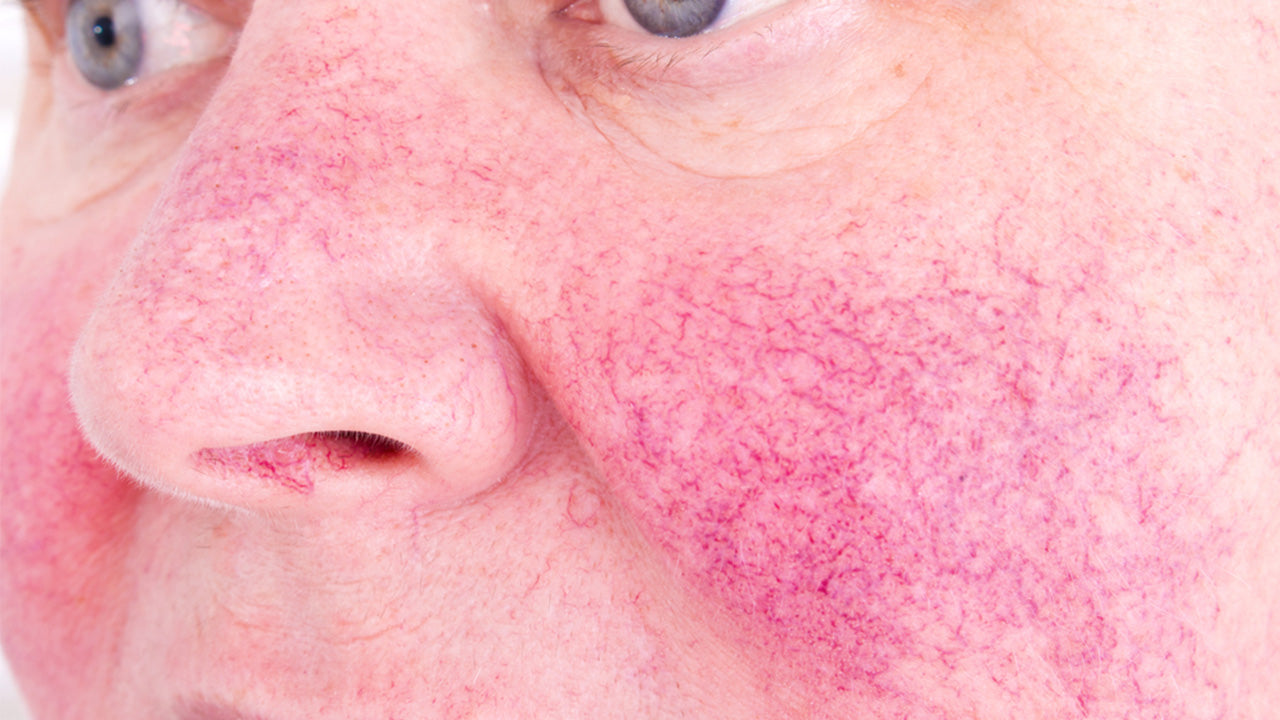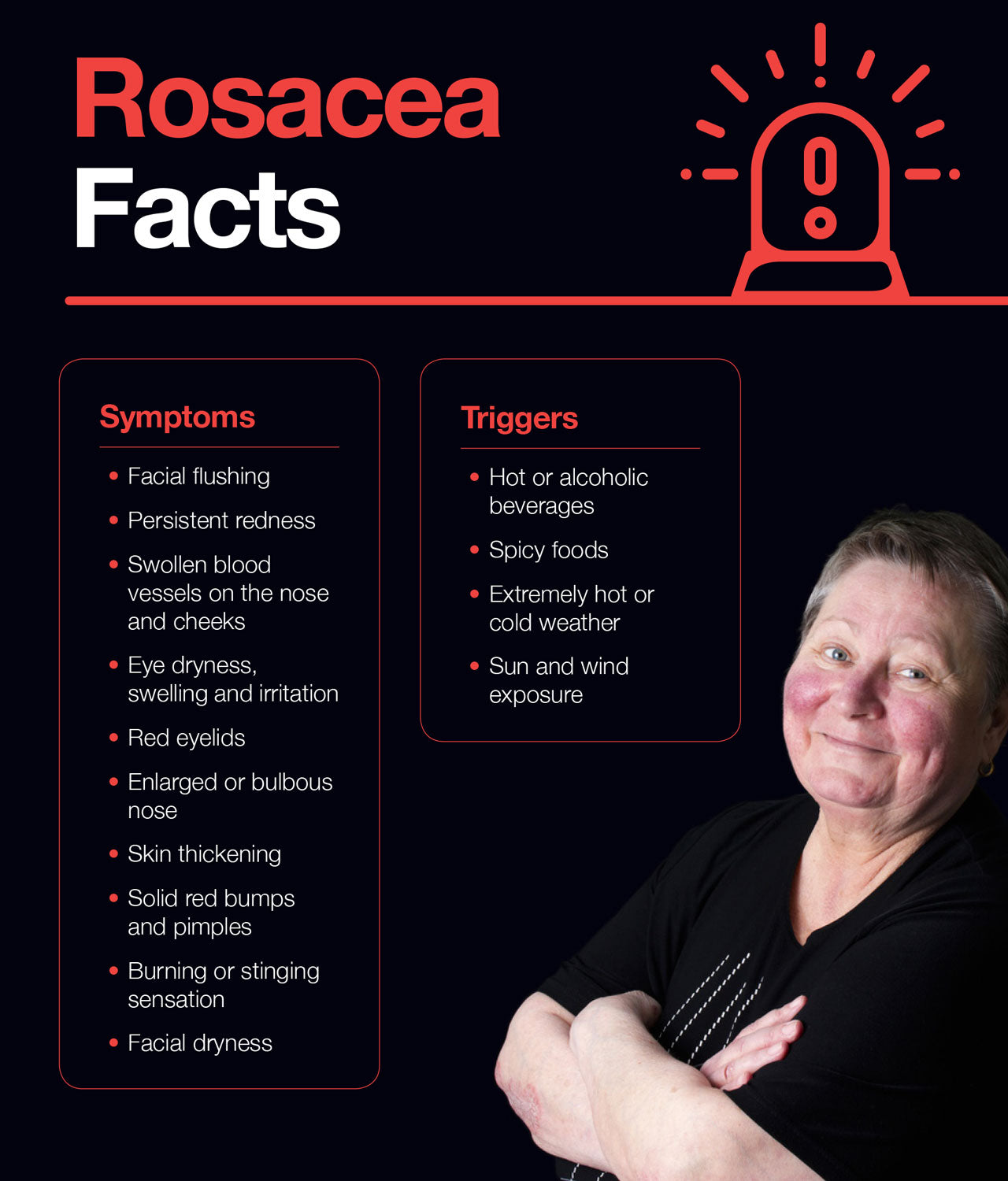Living with Rosacea: Causes, Symptoms, Treatments
 By: by Amino Science
By: by Amino Science

A skin disease, rosacea manifests as abnormal facial redness. It is often referred to as acne rosacea and can manifest as a tendency to blush or flush more readily. Rosacea can spread beyond the nose and cheeks to affect the chin, forehead, ears, back, and chest. Over time, people with rosacea may experience permanent redness in the center of the face.
The experience of living with rosacea varies based on the rosacea subtype that a patient has. The four types of rosacea include:
- Erythematotelangiectatic rosacea, which causes redness and visible blood vessels.
- Papulopustular rosacea, which causes redness, swelling, and breakouts.
- Phymatous rosacea, which results in thickened, bumpy skin.
- Ocular rosacea, which causes eye irritation, redness, and swollen lids.
Unfortunately, individuals with this skin condition often feel insecure about their appearance, and they aren't alone. According to the American Academy of Dermatology, 14 million Americans have rosacea. Learn more about what causes rosacea, as well as the symptoms and treatments that can help mitigate its effects.
Rosacea Causes
Doctors aren’t sure why some individuals develop this skin disorder. However, certain people are at a greater risk for the condition. Rosacea risk factors include being a woman, having fair skin or skin that’s suffered sun damage, being over 30, smoking cigarettes, and having a family history of the disease. While rosacea is more common in women, men are more likely to battle with severe rosacea.
Other causes of rosacea include:
- An overactive immune system: A bacteria called bacillus oleronius may trigger the immune system to overreact and cause acne-like symptoms.
- A bacterial bug: H pylori, the same bacteria responsible for stomach ulcers, tends to reside in those with rosacea, although scientists have not yet determined a definitive cause-and-effect link between H pylori and rosacea, many rosacea patients are afflicted with the bug.
- A harboring mite: The Demodex folliculorum mite seeks shelter on our noses and skin, and studies have shown that rosacea patients are especially susceptible to large numbers of this mite. However, many people have this mite on their skin, so it might not be the cause of your rosacea.
- An antimicrobial molecule: As part of the immune response, cathelicidins protect the skin from infection. But research shows they also may cause bumps, acne, flushing, and visible blood vessels, all markers of rosacea. Azelaic acid is a commonly prescribed topical medication for rosacea that helps to decrease cathelicidin production.
If you already suffer from rosacea, avoiding common triggers can help control the effects of the condition. Some of the factors that aggravate rosacea include:
- Hot or alcoholic beverages
- Spicy foods
- Extremely hot or cold weather
- Hot baths or showers
- Sun and wind exposure
- Exercise
- Certain cosmetic products
- Blood pressure medications
- Experiencing strong emotions
Additionally, experts believe that rosacea may stem from abnormal blood vessels in the face.
Symptoms of Rosacea
Facial flushing is one of the primary symptoms of rosacea. However, patients may also experience the following:
- Persistent redness
- Swollen blood vessels on the nose and cheeks
- Eye dryness, swelling, and irritation
- Red eyelids
- Enlarged or bulbous nose
- Skin thickening
- Solid red bumps and pimples
- Burning or stinging sensation
- Facial dryness
While there’s no cure for rosacea, various treatments exist to help reduce flare-ups and minimize the signs and symptoms of the condition.
Rosacea Treatments
If you’re suffering from rosacea, you might be worried about how rosacea affects your appearance. Not only are patients sensitive about their flushed skin, but they also worry about developing scars.
Here are some of the best ways to protect your skin and avoid rosacea flare-ups:
- Use sunblock. Because sun is the top cause of rosacea flares, it’s important for patients with this condition to use plenty of sunscreen when leaving the house. For best results, opt for a broad-spectrum sunblock with an SPF of at least 30. Patients should wear hats and sunglasses while outside and seek shady spots to sit when possible. It’s also wise to avoid going outside at noon when the sun is strongest.
- Take care of your skin. Because rosacea patients tend to have sensitive skin, it’s a good idea to regularly wash your face with a mild cleanser and use gentle skin care products. Apply the soap with your fingertips and rinse it off with cool or lukewarm water instead of hot. Pat your face dry with a soft, clean cloth.
- Take medication. Certain vitamins and medications can help minimize rosacea symptoms. The drug Mirvaso is designed to reduce redness. Your doctor may also recommend oral antibiotics to fight inflammation and Amnesteem to clear acne-like lesions. Some doctors recommend natural remedies like tea tree oil, green tea, vitamin B3, vitamin C, and anti-inflammatory essential amino acids.
- Consider laser treatments. If your rosacea is causing physical discomfort or interfering with your quality of life, you might want to pursue laser or light-based treatments. While insurance doesn’t typically cover the cost of light therapies, they are often quite effective. Many patients notice a clearing of broken blood vessels and redness for several years. Note that you may experience mild side effects, including redness and swelling. Most patients need multiple treatments to see results.
Living with Rosacea
It’s not unusual for rosacea patients to feel self-conscious about their condition. According to the National Rosacea Society, 41% said they avoided going out in public and frequently canceled social engagements because of their rosacea.
If you want to treat the signs of rosacea, consider purchasing green-tinted makeup. This color helps minimize the appearance of rosacea. In fact, some brands make green makeup specifically designed for people with this condition. Green-hued concealers and mineral powders can also help cover redness. Ask your dermatologist about treatments and cosmetics that can help boost your self-esteem and make living with rosacea easier.


Up to 25% off Amino
Shop NowTAGS: conditions
Join the Community
Comments (0)
Most Craveable Recipes




 833-264-6620
833-264-6620



















